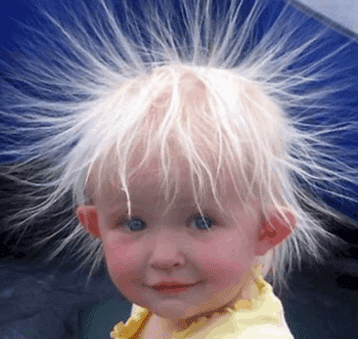Static electricity is the electrical phenomenon that causes your heirs to rise after rubbing a balloon on them.
Before delving into numerous examples of static electricity in our daily lives, we must first understand the scientific meaning of static electricity.
In scientific terms, static electricity is a non-moving imbalanced charge. It is the accumulation of an electrical charge on an object’s surface. It represents the extra charge in an electron transfer, which occurs often when two objects are rubbed together. When this buildup of static electricity discharges, a static shock occurs.
Static electricity may be seen while combing hair and the hair abruptly rises up in the direction of the comb.
Another frequent example is the sensation of being shocked after walking over a carpet and then touching a doorknob. Lightning is another example of static electric discharge. (Refer to the topic surface charge density).

Table of Contents
Examples of Static Electricity
- When two objects are rubbed together, an attractive force develops between them, especially if the objects are insulators and the surrounding air is dry. The entity that loses electrons becomes positively charged, whereas the object that gains electrons becomes negatively charged. The force is just the attraction of opposite-sign charges.
- After rubbing a piece of silk against a piece of glass, the silk and glass would tend to stick together.
- Lightning is caused by a buildup of static electricity within a storm cloud. Hydrometeors are small water molecules that travel about within clouds. These hydrometeors collide and bump into one another, causing a static electric charge to form.
Science Behind Static Electricity
All matter is composed of atoms or clusters of atoms known as molecules. The nucleus is located at the core of each atom. There are particles with positive charges (+) and particles with zero charges inside the nucleus. Protons are those with positive charges, whereas neutrons are those with zero charges. Electrons, which have negative charges (-), circle around the nucleus.
Typically, the things and materials with which we come into touch are electrically neutral. This implies they have neither a positive nor a negative charge. These items, however, are not always neutral. For instance, When you touch your hair against the ballon, electrons are transported from your hair to it. This positively charges your hair while negatively charging the balloon. Particles with opposite charges attract one another, causing your hair to stick to the balloon. Because particles with the same charge resist each other and are all positive, individual hairs will separate out.
Electrostatic Discharge
Electrostatic discharge is the emission of static electricity when two objects come into contact. Electrostatic discharge is caused by the shock we feel when we walk across a carpet and touch a metal doorknob, as well as the static electricity we feel after drying garments in a clothes dryer.
Summary
Static electricity is formed when two materials come into contact with each other. Each material is made up of electrically charged atoms. The universe has an equal number of negative and positive electrical charges (electrons) (protons). These are generally kept in balance at all times.
However, when two materials come into contact, some of the charges redistribute by moving from one to the other. As a result, one material has an excess of positive charge while the other has an excess of negative charge. When the materials split, each one takes its own charge with it. One material gains a positive charge, whereas the other loses a negative charge.
Frequently Asked Questions
1. What is the difference between static electricity and current electricity?
The primary distinction between static and current electricity is that with static electricity, charges are at rest and accumulate on the inductor’s surface. Current electricity is produced by the flow of electrons within the conductor.
2. What causes static electricity?
When positive and negative charges are not balanced, static electricity is produced. Protons and neutrons don’t move very much, but electrons love to jump about! A negative charge is assigned to an item when it contains additional electrons.
3. How to avoid Static Shocks?
You can minimize or prevent shocks caused by a buildup of static electric charges by adopting the necessary precautions. The most common cause of static electric charges in your body is dry skin rubbing against synthetic clothing. Reducing or reducing the capacity of static electricity sources to accumulate charges can help to provide respite from the shocks.
More Links
- BCl3 Lewis Structure in four simple steps - November 1, 2023
- PH3 Lewis Structure in four simple steps - October 8, 2023
- PF3 Lewis structure in four simple steps - September 24, 2023

